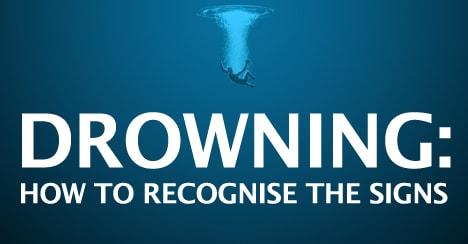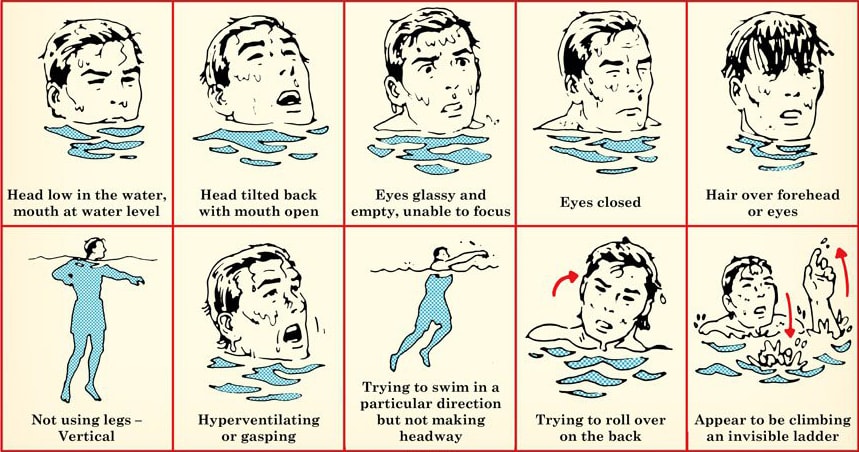Drowning- How to recognize if a child or adult is in trouble
Posted on 7th July 2015


I always thought it would be fairly obvious to recognize the signs of someone drowning. After all, I know how to swim, I understand what can go wrong, I have eyes and ears and three children and so I’m a fairly practiced parent and adult. It came as a big shock to me this week however to read an article pointing out that it’s not as easy as you think to spot the signs of drowning.
The article and accompanying video showed a pretty normal water park play and pool scene; lots of young kids, teens and adults all enjoying the wave machine when all of a sudden a life guard threw himself into the water and rescued what appeared to be a perfectly fine child. Head above water, not indicating he was in trouble and surrounded by other people who also thought he was fine. Not so, it indeed turned out that this keen eyed lifeguard had spotted all the tell tale signs of drowning and he only had 30 seconds to prevent it.
After seeing this video I started digging around and looking into the science behind drowning to understand how the lifeguard had spotted and reacted to something no one else had noticed and how I could make myself as aware of the same potential problems as that lifeguard. Having spoken at length on the subject of poo in pools and swimming in general, the information I have learnt has been eye opening and an extremely powerful lesson in not thinking you know what you’re doing just because you’re a grown up and able to swim!
As it turns out pretty much all I knew about drowning I had simply picked up from TV and film interpretations of drowning. I understood shouting, waving, cries for help and repeated sinking and spluttering as the actor came up again were pretty much spot on when it came to how a drowning would occur. This however is as far from what happens in real life as you can get.
All the above, including the waving and screaming are only there for our entertainment, because in practice drowning is a pretty silent and still process!
- A person who is drowning is physiologically unable to call for help. The body’s instinctive and primal response is to try and breathe. If it can’t do that it won’t be able to whisper let alone shout. Breathing must happen, before speech can occur.
- Drowning people’s mouths alternately sink below and reappear above the surface. In most instances the mouths of someone drowning are not above the surface of the water long enough for them to exhale, inhale, and call out for help. At the point their mouths are above the surface they only have time to exhale and inhale shallowly, they do not have time to cry for help or shout.
- Drowning people cannot wave for help. Instinct forces them to extend their arms out sideways and try and press down on the water’s surface, in an attempt to push them selves up and get their mouth above the water.
- Throughout the Instinctive Drowning Response, drowning people cannot voluntarily perform movements such as waving for help, moving toward a rescuer, or even reaching out for a piece of rescue equipment.
- From beginning to end of the Instinctive Drowning Response people’s bodies remain upright in the water, with no evidence of a supporting kick. Unless rescued by a trained lifeguard, these drowning people can only struggle on the surface of the water from 20 to 60 seconds before submersion occurs.


So how do you spot a potential drowning?
There are a number of tell tale signs to watch for in a swimmer you think may be in trouble in the water. A person in trouble need not display all the below but even one or two of these signs should be enough for you to go ahead and intervene and ask if they need help.
1. Is the swimmers head low in the water with their mouth just visible for more than 30 seconds?
2. Is the head tilted back and mouth open?
3. Do they have unfocused or glassy staring eyes?
4. Or are their eyes closed?
5. Is their hair over their face or eyes and hasn’t been pushed back?
6. Are they vertical in the water i.e. not using their legs to swim?
7. Are they gasping or breathing very quickly?
8. Are they trying to roll on their back?
9. Do they look like they are trying to climb an invisible ladder
It’s always better to be safe rather than sorry, even in crowded holiday parks and communal pools drowning occurs. In a recent meeting with a number of Leisure Centre officials, I was told that the first place they look for a lost child is at the bottom of the pool!
The statistics for drowning in the UK are as high as ever and whilst it’s vital to teach your kids to swim, it’s just as important to understand how to identify a person in trouble in water and then what to do should it happen. So get yourself aware, take note of the points above and be on guard whenever you are in or around water. We can all be lifeguards to our children, friends and strangers if we know what to look for.
Safe & happy Splashing
The Splash Lab
